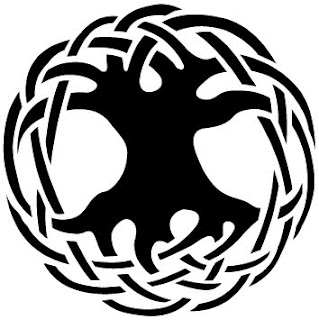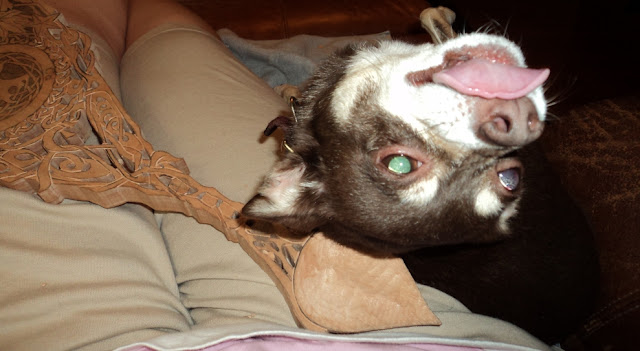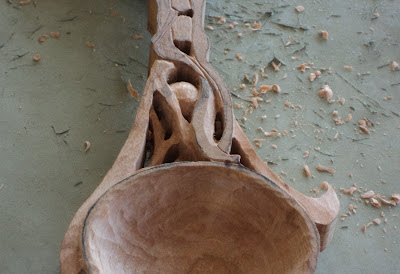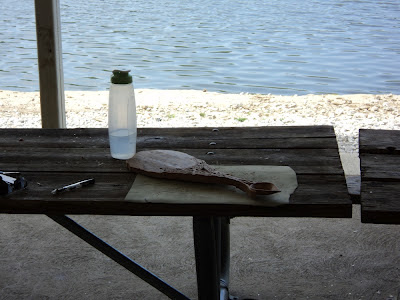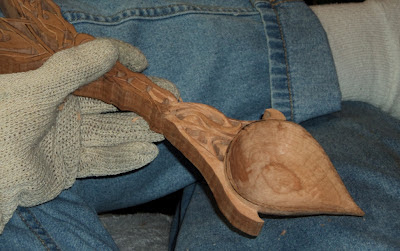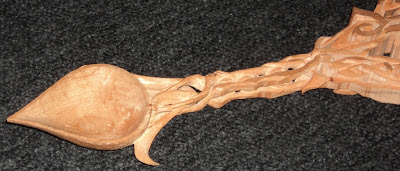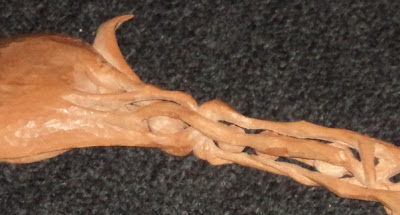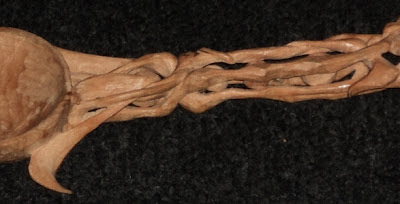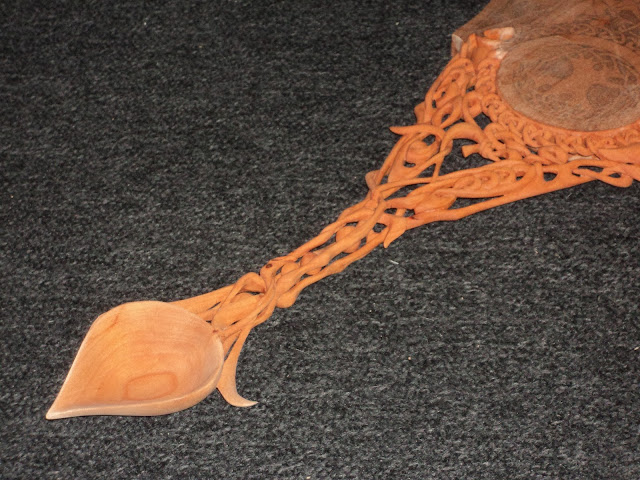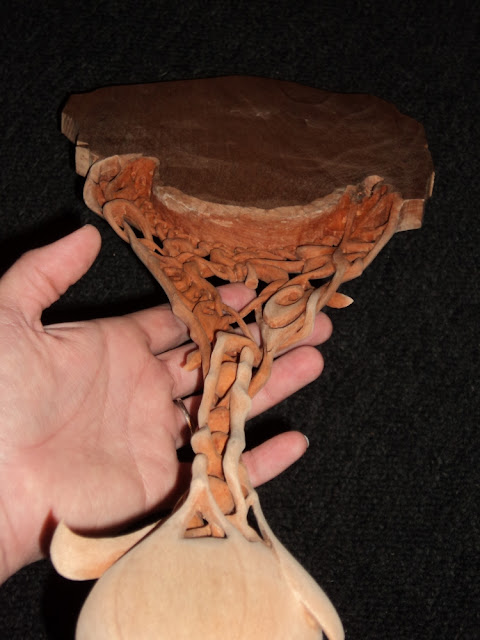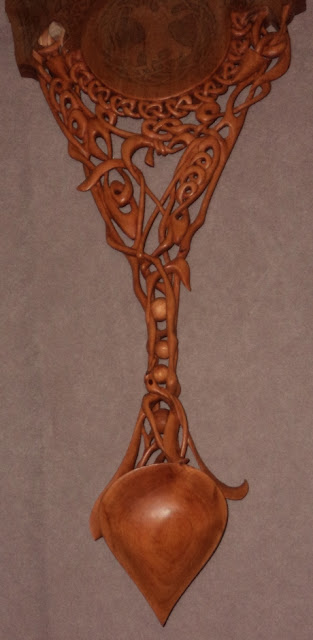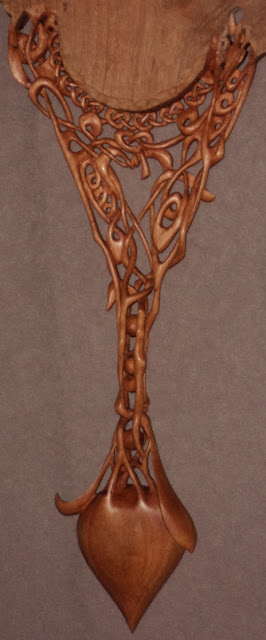![Bookmark and Share]()
You know - when I talk with people about lovespoons, they often ask about whether it bothers me to always have to part with a spoon after having put so much of my heart and soul into it, not to mention the hours and hours of hard work. I generally give the same reply: Nope. Lovespoons are, after all, meant to be given away, and I just think the world needs more lovespoons. But, I digress. Getting back to the point I was intending to make: this spoon, I think, even though I'm only one of four contributors to it, may be the first one I think might give me a bit of an ache when I part with it. As I've watched the design develop, I keep thinking this one just seems special. I determined long ago that I if I ever get a lovespoon, I won't get it myself, because I'm a girl, so I won't buy a chance at it. But YOU can! I feel compelled to say - if you haven't already bought your raffle tickets for this year's spoon: you should. Just click on the "Donate" button at the right to make a secure payment to buy your chances. It's only a dollar for a chance! And you'll be supporting a really terrific cause! I wonder if everyone reading this realizes what an opportunity there is here.... it's a little bit amazing to me. Just sayin'....
Well, back to the spoon... Dave and I may be jumping ahead a little, but that's only because we're pretty excited that we think we may have just finished the design! I'll try to include a few notes Dave gave me along the way, here, but there will probably be some reviewing of more of how we got here in later posts. So here it is!
But, I guess I should elaborate a little about how we got here...
Last time I wrote, the cage was pretty much settled, and Dave was working on some ideas for what to do in the upper part of the spoon, building around that medallion, with that generally tapered overall frame-shape. Now, Dave had mentioned he had an idea for a dragon above the medallion - hinting at Welsh roots - maybe some maple leaves and stars, too. I was very curious, but also very busy with several other spoons and a lovespoon workshop, so I just tried to leave Dave alone and wait. Eventually, I heard from Dave that he was struggling with a bit of designer's block (I sympathized), but he pushed through it, and before long, he came back with this, with the accompanying qualifier that he wasn't happy yet with the dragon.
![]()
Since he wasn't quite happy with the dragon, he suggested that I should feel free to try to "jazz him up a bit." We had also talked about running some vines (or roots) through/around the upper part, and he said he had tried adding in some vines, but felt it might be starting to look too busy, but maybe I'd have more luck with it if I wanted to try. Knowing I still needed to draw the lower part to come up and meet this part, he suggested that maybe we could have vines intertwined around that lower part, around the ends of the tongue and tail. He also mentioned that he was working with a 4.25" diameter circle, there, but I could probably increase it to 4.5" if I felt like it needed to, or even go as small as 4 inches before the medallion started becoming too tricky to carve.
When I saw this, I was a little surprised because it wasn't what I was expecting - although, I wasn't sure what to expect, either - so I just had to think about it for a minute. In our first discussions, we did talk about a root framework for everything, but we also talked about having some other big element above the circle, crowning off the top section of the spoon, but we couldn't seem to come up with what that element would be to put up there then. So I don't know if I even mentioned that part of the original plan before, but anyway - this was definitely a return to the original plan. And I really like it when Dave makes maple leaves. I also love the dragon's wing, and what he's done with the tongue and tail. But I wondered what, specifically, Dave didn't like about the dragon, if he wanted me to try my hand at it.
And then I started to wonder whether Dave had looked at both parts together yet - he hadn't mentioned. I was curious about something, but needed to see everything together. Bringing everything together would be the next step, anyway - so at my next opportunity, I printed the image above so that the circle would measure 4.25", and got out my print-outs from before, and looked at them together. I looked at the 4.25" version, which fit, and the 4.5" version, which also fit, but felt a little more securely. So, here are both parts together.
![]()
I didn't shade in the negative space yet this time, but remember, also, the medallion is largely fretwork, while the leaves and stars and dragon are all solid figures. So, then, the thing I was wondering before was this: would these two parts look harmonious and integrated, or would there be a distinct difference in proportion? Remember - I had already spent quite a bit of time contemplating that medallion at those smaller sizes. Looking at them together, I did feel like there was a small disconnect, but at the same time, I saw what I thought might be a pretty simple solution.
I proposed that adding few thinner vines (about the thickness of the vines in the knotwork around the medallion, or the tree) up in there as a transitional element might actually be just the thing to blend the two parts together. Yes, it would add a little business, but it needed a little business, to match the business of the fretwork within the medallion. Anyway, Dave seemed to agree about the disconnect, and about the proposed solution, so that was simple enough. As a bonus, it might help with that overall continuity to have a bit more of some organic stuff in that upper section, too, since there is a lot in the lower section. Likewise, I now knew I would need to add more non-organic stuff in the lower section, too.
So - I do ramble, don't I?! Sorry about that. A lot happened. Well - first things first - I asked Dave what he didn't like about his dragon. He said he didn't like its face, but also said I should play with any other parts, and make him look "more serious", if I wanted. So I started with the face, but then, just for fun, I did play with a few other parts, and here's what I sent off to Dave....
![]()
Dave wrote back saying that he liked it, and he thought we should run with it, so I said ok and moved on to the next step. So, the next step was to patch this together with the lower section I'd done with the cage. I laid out a center line - decided the points of the heart would define vertical - and placed everything so that tip of the bowl to the top of the dragon's wing is about 21 inches - the previously-agreed length, and also marked out 3.25 inches left and right of the center line in the top area (7.5 inches total width), just to help keep track of the balance. Then it was just a matter of drawing.
Now it was my turn for designer's block. I had been so focused on roots, but just roots and vines would be too much organic, and wouldn't really have any continuity with the upper part at all. While I thought about it, though, I added some of those filler vines through that upper part to temporarily hold everything together (Dave could totally change them if he didn't like them - just as long as he still made them as thin as the knotwork and tree, so they serve that transitional purpose previously discussed) Also, I think I had them all beginning and ending somewhere, but I was a little sleepy, so he needed to check, if he didn't want to change them all together. I tried to do things like twist multiple vines together so that they were in bundles, but weren't really that fragile, or laid them against leaves or other things, so they still had that thinner scale like the knots and tree in the medallion, but also had strength. Anyway... eventually, I figured I would start by mirroring the heart Dave had put above, only I'd make this one out of a vine, kind of like a bit of grapevine. And then, for some of the other areas I needed to fill, I'd make up some knots. I tried to give them a feel kind of like what Dave had with the tongue and tail of the dragon, again, trying to carry some uniformity through the design. Definitely David Western inspired knotwork. :) Oh, and I kind of abandoned some of the constraints of the framework shape, too... I really don't know what made me do that. Hmm.
Anyway, here's the first draft I sent him...
Well, Dave liked it. He even liked the vines through the upper part - although he did have concerns about the thinness of some, and did find a few mistakes where I'd lost track of some vines. So I made a few fixes, had a few second-thoughts, re-arranged a few things, and beefed up a few vines I thought might be giving Dave a little extra concern in that upper part, and here's where we are now.
So here we are! Looks like we have a design!
OH! by the way, this spoon will be made of a nice cherry board that is sitting next to me right now.

